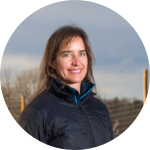About This Project
Our goal is to develop the use of hair as a novel and non-invasive tool to understand muskox health and predict population trends. Specifically, we will investigate the association of essential trace mineral levels in hair with the health of the individual muskox and, ultimately, use this to predict population trends. This non-invasive tool will have great value for the conservation and management of muskoxen and other wildlife.
Ask the Scientists
Join The DiscussionWhat is the context of this research?
Monitoring population health and predicting population trends is at the core of species conservation. However, traditional population surveys are time consuming, expensive, or logistically difficult. This is particularly true in the Arctic, where climate change is happening at an alarming rate and wildlife are at risk. Indeed, widespread declines of caribou (1) and large-scale mortality of muskoxen (2) with ongoing health issues (3, 4) highlight the need for an improved understanding of the health of these species. Assessing the mineral status may be a viable option, as minerals and their tight linkage to animal health, immunity, survival, and reproduction is well documented (5), and could be coupled to population dynamics (6, 7).
What is the significance of this project?
The Arctic is changing rapidly and with that, the flow of trace minerals through the ecosystems is changing (8). Wildlife health in the Arctic is also changing, with iconic and key species (muskoxen and caribou) undergoing disease outbreaks and widespread population declines (1, 2, 3, 4). Trace minerals are essential for life and immunity, yet mineral deficiencies are emerging as population limiting issues for these species. Our research aims to validate the use of hair minerals as a non-invasive tool that provides both an index of individual health and is a prospective indicator of future population trends. Such a tool will have great value for the conservation and management of wildlife populations where traditional monitoring is not feasible.
What are the goals of the project?
Our research will use muskox hair to (i) determine the current trace mineral status in muskoxen across their natural range, and (ii) evaluate the association between mineral status and population health and trends.
We expect when hair concentrations of important minerals are low, we would see detrimental effects on the health of animals and populations trends. The important elements will be selenium, copper, molybdenum, magnesium, zinc, and more. To evaluate the health of animals, we will be testing blood samples for a range of diseases, as well as indicators of inflammation and overall health. Additional health indicators will include information on sex, age, body condition, pregnancy, parasite and pathogen infection/exposure, and clinical symptoms of diseases.
Budget
We will assess mineral levels in muskox hair and evaluate their association with animal health.
Samples will be analyzed by ICP-MS to determine the hair concentration of approximately 60 elements. Here the important elements will be selenium, copper, molybdenum, magnesium, zinc, and more. Part of the funding will cover these expenses.
To evaluate the health of animals, we will be testing blood samples for a range of diseases, as well as indicators of inflammation and overall health with ELISA kits. Part of the funding will cover these expenses.
If funded, the money raised will be used to analyse hair samples and blood samples of muskoxen from Canada and Greenland. This project already has substantial funding covering salary and other expenses involved with the project, including the capture and collection of samples from remote areas.
Endorsed by
 Project Timeline
Project Timeline
For this project we will use archived samples from collared muskoxen captured since 2013 from populations in east Greenland, Quebec and Yukon.
During August - December 2018 samples will analyzed in the laboratory. Hair samples will be analyzed for mineral content with ICP-MS, while serum samples will be screened for diseases and inflammation indicators.
From January 2019 and forward, the data will be analyzed, and we will start disseminating the results.
Aug 21, 2018
Project Launched
Dec 31, 2018
Analysis of serum samples for diseases, inflammation, and other general health indicators.
Dec 31, 2018
Analysis of hair samples for mineral levels
Mar 31, 2019
Analysis of our data
Jul 01, 2019
Ongoing dissemination of results, e.g scientific publication, seminars, outreach to the public, and more
Meet the Team
Affiliates
Team Bio
This project is a multi-disciplinary collaboration of researchers, wildlife biologists, and First Nations, Inuit and Metis community members across Canada and Greenland. The team includes international experts on arctic ecology, including muskox health and ecology. It builds on the existing Dr. Kutz Lab network (http://people.ucalgary.ca/~kut...) and program of community-based wildlife health monitoring, and includes both national and international team members and collaborations.
Jesper Bruun Mosbacher
I am a postdoctoral fellow working in the Kutz lab at Department of Ecosystem and Public Health at the Faculty of Veterinary Medicine at University of Calgary, Alberta. I will be the main researcher connected to the project.
I started going to the Arctic already during my bachelors, and it was love at first sight. Since then, I have been part of the extensive ecosystem monitoring at Zackenberg in Northeast Greenland, as well as conducting my own research. My PhD thesis was focused on muskox ecology and health, and included work collaring and sampling from muskoxen, as well as work with muskox hair as a tissue to reveal nutritional records and mineral concentrations.
Susan Kutz
The Arctic found its way into my heart after my first summer job in the Yukon. Ever since I have been fascinated by the beauty, the animals, and the people of the Arctic. I've spent over 20 years working with northern communities to understand the impacts of a warming Arctic on the health of muskox and caribou populations and the consequent effects on food security in the Arctic. My areas of expertise include wildlife parasitology, disease ecology, ecosystem health, arctic ecology, climate change, and community-based wildlife health surveillance. My energy is derived from the fascinating systems and people with whom I work.
Additional Information
Project Backers
- 9Backers
- 10%Funded
- $446Total Donations
- $49.56Average Donation



